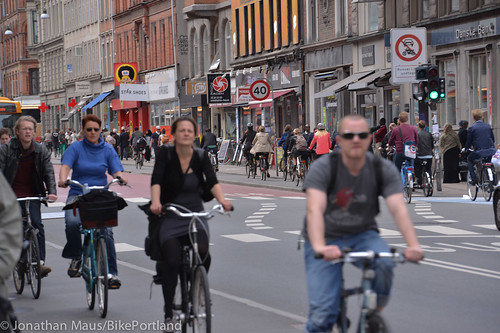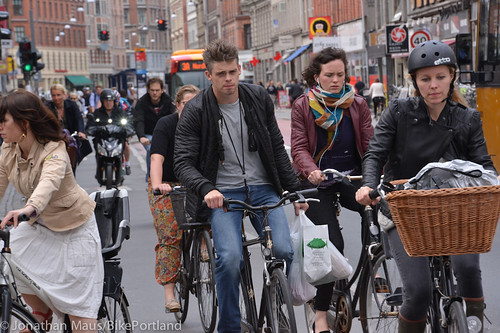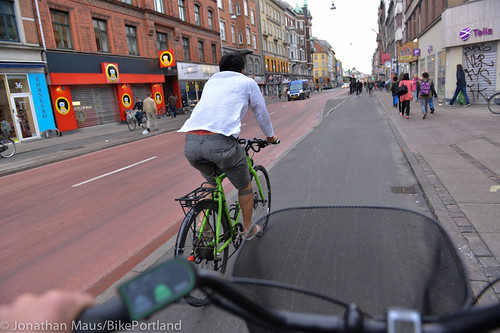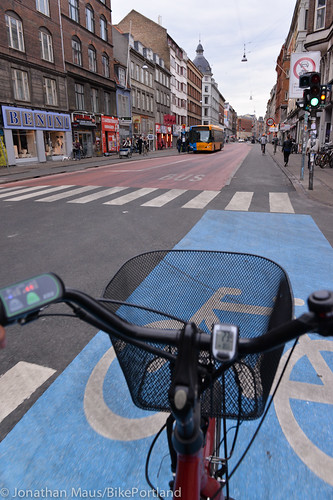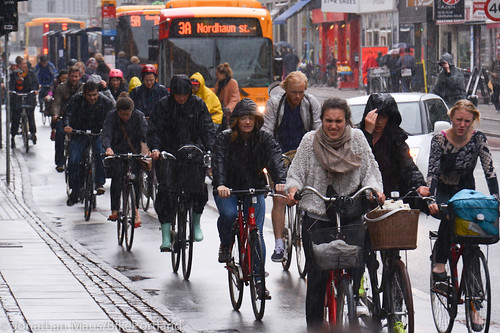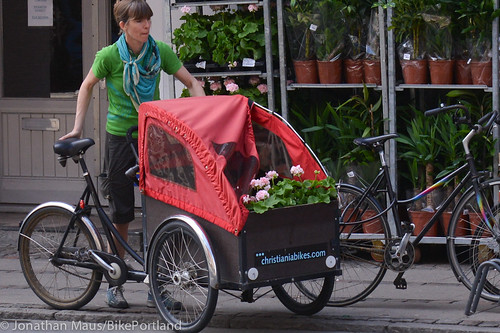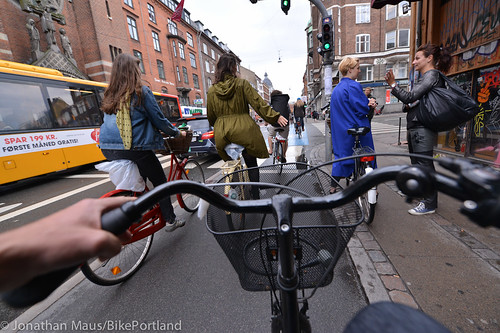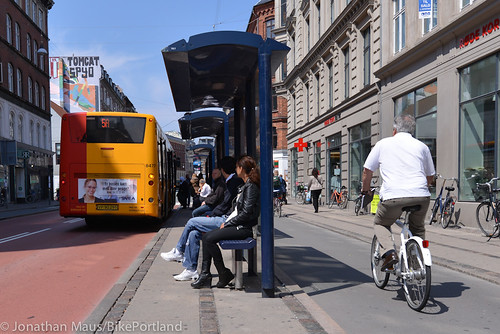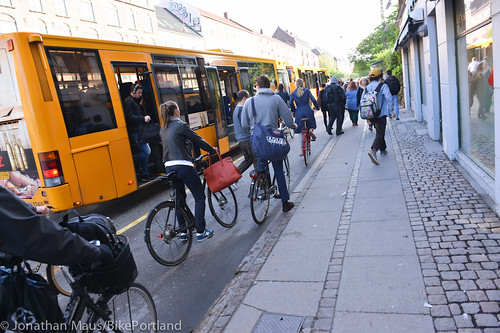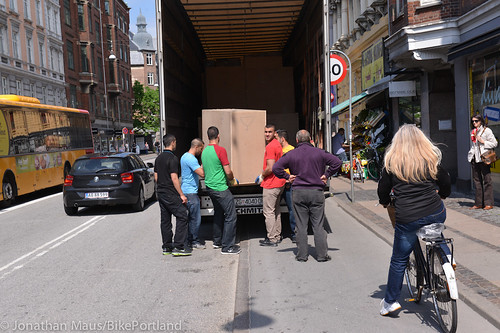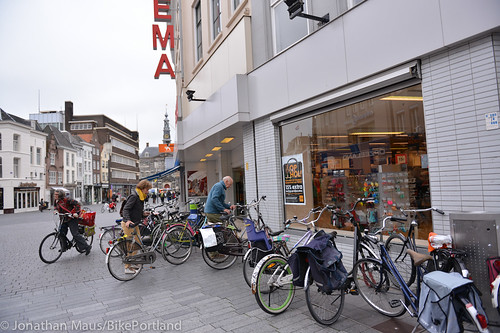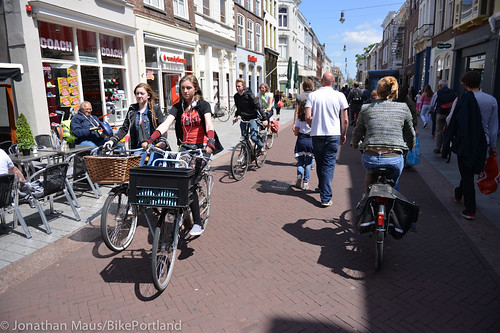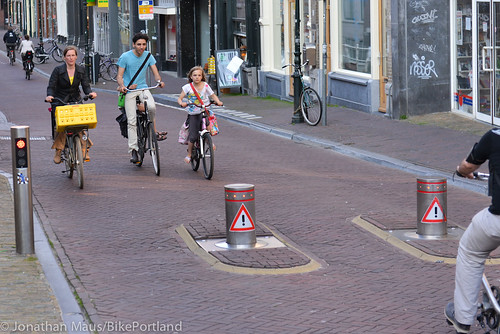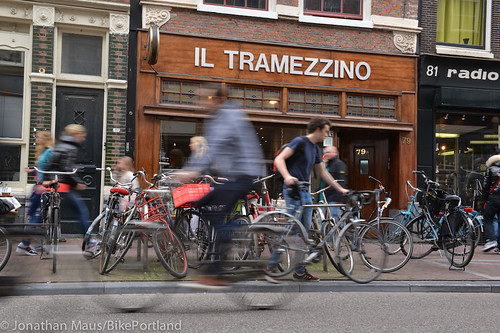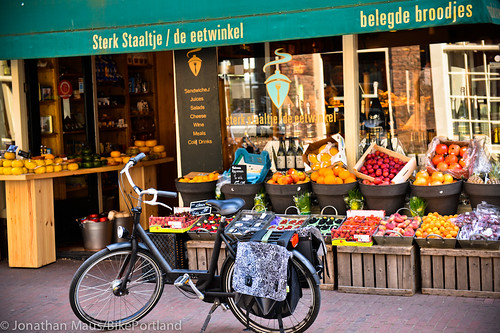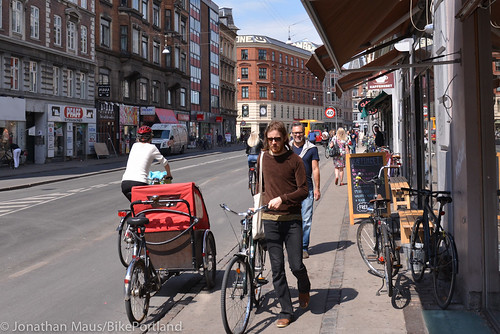
(Photos © J. Maus/BikePortland)
Living in the U.S. it can be difficult to keep the faith in the bicycling vision. The incessant marginalization of cycling by our national transportation culture, reluctant media, and timid leaders can introduce doubt into the minds of even the most fervent bicycle believers. But if there’s one thing that I learned spending two weeks in the best bicycling cities in the world, it’s proof of concept that bicycling can be an essential ingredient to successful public spaces. Despite what the naysayers continue to push back against, once you’ve spent time in cities like Copenhagen and Amsterdam you realize that yes, indeed, it’s absolutely possible to have a low-car city that teems with economic vibrancy and happy, healthy citizens that have access to all the services they need without having to use a car.
Take Nørrebrogade in Copenhagen for instance. This street was transformed back in 2007-2008 by a visionary mayor who had the guts to push a revitalization of this previously lackluster thoroughfare that put people above auto capacity. Nørrebrogade was reconstructed with bus-only priority lanes, cycle tracks that are 16-feet wide in some sections, and improved sidewalks. There is no on-street auto parking and for several blocks, if you want to drive on the street you must turn off it and go around a bus/bike only section. The result is a 50% reduction in auto volume, large increases in people cycling, taking transit, and walking, and a commercial environment that would be envy of any business owner.
According to one analysis, “The municipality’s assessment [of the project] has suggested that it is possible to reduce the volume of car traffic by 50% without negative consequences for the surrounding residential streets.” In other words, people simply decided to drive elsewhere and/or they switched to modes that were more welcome on Nørrebrogade.
“The Nørrebrogade project created a lot of trouble. Business owners said they would be killed.”
— Niels Hoe, former City of Copenhagen manager of bicycle parking
That large reduction in auto traffic is key to understanding why this — and many other streets like it — are a success. Fewer cars means more space, less noise, better air quality, and a safer, comfortable environment that fosters more business and social interactions. One thing it doesn’t mean is a lack of economic vibrancy. In fact, the opposite is true.
“In 2008, the street was dead,” quipped Mikael Colville-Andersen when I chatted with him about Nørrebrogade. Colville-Andersen, the noted bicycle blogger behind Copenhagenize (not to mention author, photographer, speaker, international mobility consultant, and so on), credits the Nørrebrogade project to former Mayor Klaus Bondham. What started initially as a pilot project, he said, has now become a model and the City of Copenhagen plans to recreate its success on other streets.
Niels Hoe, a former City employee who worked on bicycle parking and planning, said even in Copenhagen such an ambitious undertaking wasn’t easy. “The Nørrebrogade project created a lot of trouble,” Hoe shared during an interview in a cafe along the street last when I was there last month. “Business owners said they would be killed.”
Today, businesses are going gangbusters on Nørrebrogade. The sidewalks are full of people (many of them pushing strollers) and the constant stream of people on bikes and in buses provide shop owners with a huge captive market of potential customers. The amount of bike shops alone is staggering: about 50 bike shops (estimates one shop employee I asked) on or near the main stretch of Nørrebrogade.
It’s important to understand that the City of Copenhagen was thoughtful about how they designed the bus and bike facilities: Key design details make Nørrebrogade welcoming for users of both.
The cycle track was purposefully made wide enough for social cycling. It’s easy to carry on a conversation and in sections where it’s especially wide — over 16-feet! — the City has painted small arrows to facilitate passing. (Amazingly, you can ride side-by-side with a friend and have someone pass both of you and still not feel crowded.) Another key design feature of Copenhagen’s cycle tracks are the very small curbs and ramps which allow people on bikes to easily move from the cycle track to the sidewalk or the street. This is important to maintain the flow of bike traffic. If a truck is blocking the cycle track for instance, it’s easy to hop down or up the curb to get around it. If you see a friend on the sidewalk — or an item for sale in a store window that catches your eye — it’s easy to pull over without much effort.
For bus riders, not only is service on Nørrebrogade frequent and fast, the stops are very civilized. Instead of being on the curb, the stops are placed on median islands in the roadway. This keeps the stops and their users off the sidewalk space and it allows bicycle traffic to flow freely behind it. Or, when stops are on the sidewalk, the bus lets off in the main roadway and the doesn’t block the cycle track. Thus, the dreaded “leapfrog” bus/bike dance is completely avoided. (This is exactly the configuration some folks hoped for on N. Williams, but alas, various demands from TriMet squashed the idea early in the process. It’s also what we have today on SW Moody near Gaines in South Waterfront) What happens when a lot of people step off the bus and walk over the cycle track toward the sidewalk? Amazingly, the sky does not fall. People on bikes stop, wait, and everyone manages with no big whoop.
Of course Nørrebrogade is not perfect. In some parts the sidewalk feels cramped and there’s so much bike traffic that the street feels a bit chaotic during rush hour (I happen to love that chaos). Also, when businesses do need truck access, there’s really no place for them to go so they usually straddle the road and the cycle track. In one case I saw a large truck that completely blocked the cycle track while workers moved several pieces of furniture into a store. But in both those cases, no one seemed upset. There were no middle-fingers or yelling from anyone. People just went about their business.
And don’t forget that it’s not just the main street of Nørrebrogade that benefits, there are myriad wonderful side streets that where auto traffic has also been kept in check.
During my time in the Netherlands, I also saw many examples of thriving commercial streets and plazas where bicycling and walking were given the highest priority:
There was Market Square and its side streets in ‘s-Hertogenbosch…
The entire city center of Delft (and other cities) is traffic calmed through the use of bollards…
And then there are bustling business streets like Haarlemmerstraat in Amsterdam which survives pretty much exclusively on biking and walking traffic…
In city after city where people had priority over cars I saw small businesses, public spaces, and life in general — flourishing. How is it possible?! Don’t those businesses need cars to survive? What about emergency vehicle access? What about freight trucks? We are very good in the states at finding reasons we can’t do things; but even though I’m aware this is far beyond an apples-to-apples comparison, it does give me hope to know that there are places in the world where human beings live — and live well — without cars at the center of everything.
— Read more of our coverage from Copenhagen and The Netherlands here.


